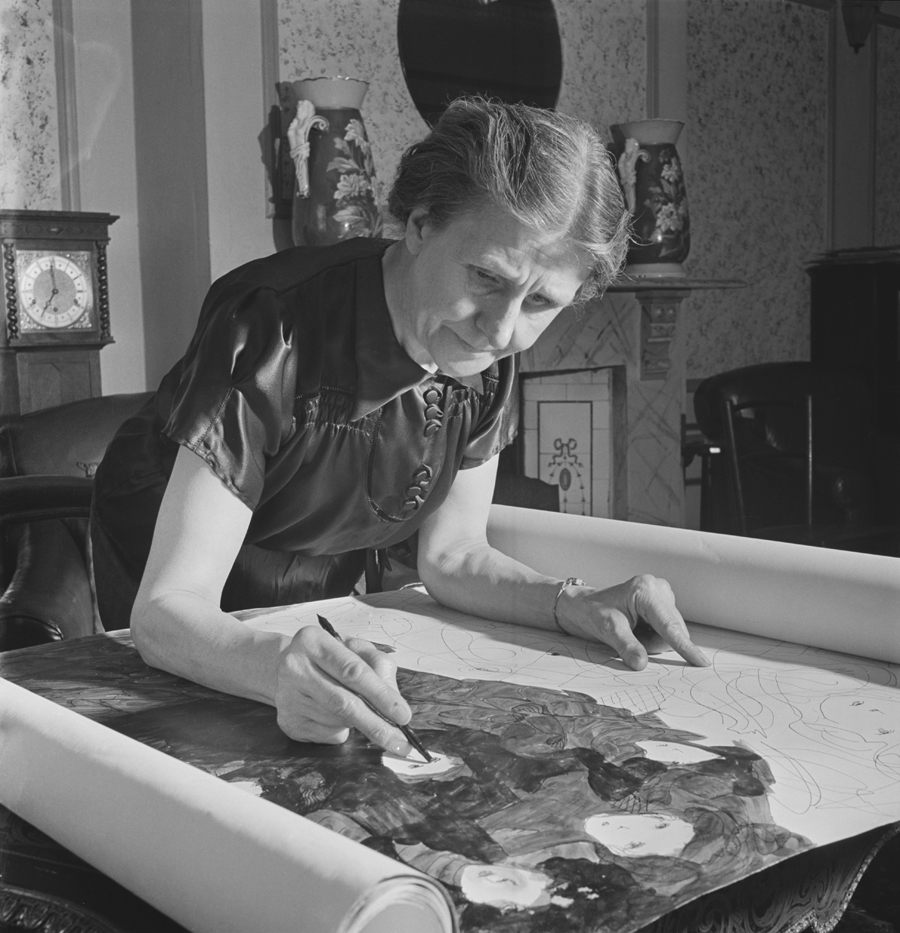Madge Gill’s Otherworldly Art
Found stashed under her bed when she died, the spiritualist’s drawings and embroideries go on show at William Morris Gallery
Found stashed under her bed when she died, the spiritualist’s drawings and embroideries go on show at William Morris Gallery

Cross the threshold into the exhibition of works by Madge Gill at William Morris Gallery and you’ll find yourself in a silken web. All four walls of the small space are filled with the self-taught spiritualist artist’s feverishly detailed drawings, embroideries and textiles, which she stashed under her bed and in the back of her wardrobe. Many have never before been shown in public.
Gill was born in a low-slung building beside the former Cock Tavern in Walthamstow in 1882. An illegitimate child in the Victorian era, she was sent to an orphanage aged nine and, from there, shipped off to Canada aged 14, where she worked as a farmhand. By the time she was 19, she’d saved enough money to return to London, where she married her cousin and had three sons – one of whom died from influenza. After giving birth to a stillborn daughter and experiencing a deterioration of her own health, including the loss of sight in her left eye, Gill spiralled into depression.

It was on 3 March 1920 that Gill first claimed she was ‘possessed’ by Myrninerest, a spirit guide who sparked in her an uncontrollable surge of creativity. From that day on, she produced thousands of works – primarily ink on paper or calico, but also hand-embroidered silk-and-wool rugs and clothing. She worked quickly, often at night, a candle flickering beside her, escaping from her unhappiness and connecting with her lost children through art. At William Morris Gallery, glass cabinets are lined with painstakingly crafted postcards, of which she would create up to 100 at a time.
Ranging from postcards to sprawling drawings on vast rolls of calico, Gill’s work flirts with abstraction without fully succumbing to its grasp. In and among her frantic scribbles a woman’s face often appears: doll-like with button nose, pointed chin and doe eyes seemingly lined with kohl. In some works, it’s tethered to a flowing robe and lined up alongside others, recalling processional groups on a classical frieze. Elsewhere it’s floating, ghost-like, eerily detached yet ostensibly alive. It’s up to you whether you take this young woman to be Gill’s lost daughter, Myrninerest or the artist herself.

Tribal masks also emerge from the overlapping layers, with crosses for eyes and arched, entrance-like mouths. Repetitive patterns evoke fluttering feathers, necklaces dripping with pearls, chessboards and cigarettes leaking smoke. Most of her work is black and white, some pieces constitute one colour in several shades, a handful are multicoloured. It’s hard to look at Gill’s velvety embroideries and not picture the meticulously woven threads morphing into a bird of paradise.
A movement that began in the 1840s in upstate New York, spiritualism attracted many followers in Victorian Britain and around the world – people who believed that the dead could communicate with the living. When Gill started communicating with spirits through her hallucinatory drawings after World War I, she was continuing in the vein of pioneering women artists such as Anna Howitt-Watts and Georgiana Houghton, who were among the first abstractionists.

Gill often exhibited her work at the Whitechapel Gallery’s open exhibitions, but attributed it to Myrninerest and – unwilling to part with it – intentionally set such steep prices that it wouldn’t sell. When she died in 1961, aged 79, her son Laurie found her life’s work crammed into every nook of her east-London home. He donated almost 2,000 pieces to Newham Council and another 2,000 were sold through auctions and private sales. Sophie Dutton, who curated this show together with William Morris Gallery, discovered 11 embroideries just last year. No doubt more of Gill’s work is yet to surface, but this exhibition offers an immersive experience in her world, a chance to get caught in a mysterious, mystical web.
Main image: Madge Gill, Untitled, undated, black ink on card. Courtesy: Newham Archives and Local Studies Library
























